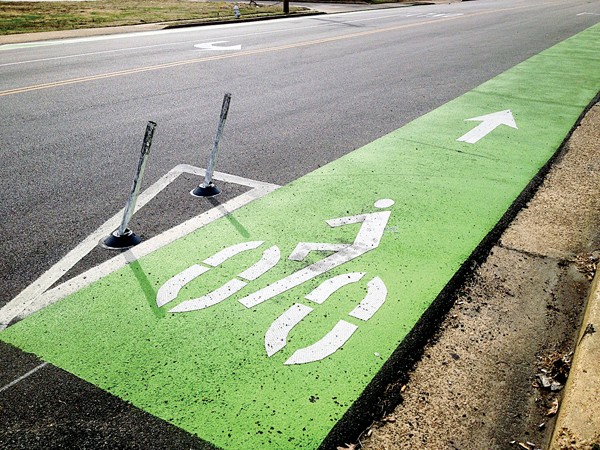Memphis is rolling forward with its bike-focused efforts as green lane projects have been announced throughout the city and two new cycling campaigns are underway.
Green lanes, named for their green paint rather than environmental impact, is the term for the types of protected bicycle lanes where there is a buffer between moving bikes and moving cars.
“That buffer area can take different forms,” said Kyle Wagenschutz, the bicycle/pedestrian coordinator for the city. “It could be that you paint the buffer area in the roadway. It could be that you use parked cars as the buffer area, so instead of having the parked cars against the curb, they would be a little off the curb, and the [bike lanes] would be against the curb. That wall of parked cars creates the buffer.”
The city’s first green lane was striped last year on Overton Park Avenue between Cleveland and Bellevue, the same year Mayor A C Wharton committed to building 15 additional miles of bike lanes. The city is in the process of exceeding that goal — 22 miles of lanes have been identified and funded. Eighty percent of the total project costs will be funded through federal grants, with the city having to match the remaining 20 percent.
 Bianca Phillips
Bianca Phillips
Since 2010, the city has already constructed 71 miles of bike lanes and paths, but most of the lanes on city streets are not buffered from traffic.
Perception of safety is important to get more people riding bikes, Wagenschutz said, and green lanes help soothe concerns. According to the city, the number of people cycling has doubled over the past three years, and the number of accidents has decreased 32 percent. With those statistics, the highest-used bicycling facilities in the city are ones that are separated from moving cars like the Shelby Farms Greenline and the Wolf River Greenway.
“The Wolf River Greenway, on a weekend, will see 2,000 people a day. On that same gorgeous, beautiful day, we’re unlikely to see that same usage on Madison Avenue,” Wagenschutz said. “It’s because the Wolf River Greenway, in addition to being aesthetically pleasing, provides a level of comfort.”
Ideas for the green lanes and bicycle-centric designs come from countries in Northern and Western Europe such as Denmark and the Netherlands — both of which have large cycling populations.
“We’re taking inspiration from how they designed their roadways in those countries and importing it back to America, adapting it for the culture and the design that’s prevalent here in the U.S.,” Wagenschutz said. “They have mastered the art of design for roadways in such a way that it’s created these kinds of spaces for bicyclists and cars to operate independently of one another.”
The city has also launched the “Get There Together” campaign to put the focus on people, rather than choice of transit, to try and change the mindsets of how people travel within Memphis.
“This new way of thinking embraces the mutual obligation we each have to each other to make sure we’re attentive, conscientious, and respectful to one another, regardless of how we have chosen to get around,” reads the Get There Together blog.
Wagenschutz has also been working on a month-long project for the city called the 30-Day Car-Free Challenge, where for the month of April, Memphians can commit to change their mode of transportation, even for a day, and be entered into contests for prizes. More information about both campaigns is available at